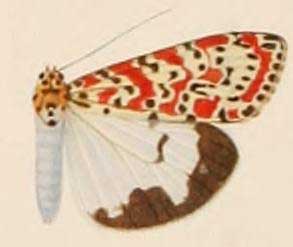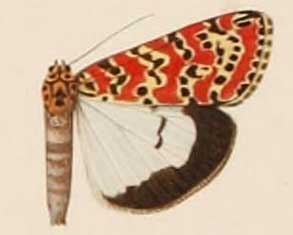Superregnum: Eukaryota
Regnum: Animalia
Subregnum: Eumetazoa
Cladus: Bilateria
Cladus: Nephrozoa
Cladus: Protostomia
Cladus: Ecdysozoa
Cladus: Panarthropoda
Phylum: Arthropoda
Subphylum: Hexapoda
Classis: Insecta
Cladus: Dicondylia
Subclassis: Pterygota
Cladus: Metapterygota
Infraclassis: Neoptera
Cladus: Eumetabola
Cladus: Endopterygota
Superordo: Panorpida
Cladus: Amphiesmenoptera
Ordo: Lepidoptera
Subordo: Glossata
Cladus: Coelolepida
Cladus: Myoglossata
Cladus: Neolepidoptera
Infraordo: Heteroneura
Cladus: Eulepidoptera
Cladus: Ditrysia
Cladus: Apoditrysia
Cladus: Obtectomera
Cladus: Macroheterocera
Superfamilia: Noctuoidea
Familia: Erebidae
Subfamilia: Arctiinae
Tribus: Arctiini
Genus: Utetheisa
Species: Utetheisa pulchella
Subspecies: U. p. dilutior – U. p. kallima – U. p. pulchella
Name
Utetheisa pulchella (Linnaeus, 1758)
Type locality: in Europa australi; in Mauritania.
Synonyms
Phalaena Tinea pulchella Linnaeus, 1758
Noctua pulchra [Denis & Schiffermüller], 1775, nomen nudum
Phalaena Noctua pulchra Esper, 1786
Deiopeia thyter Butler, 1877
Utetheisa pulchella ab. thytea, in: Rothschild, 1914
Utetheisa shyama Bhattacherjee & Gupta, 1969
Utetheisa shiba Bhattacherjee & Gupta, 1969
Utetheisa menoni Bhattacherjee & Gupta, 1969
References
Witt, T.J. & Ronkay, L. (Eds.) 2011. Noctuidae Europaeae. Volume 13. Lymantriinae and Arctiinae, including phylogeny and check list of the quadrifid Noctuoidea of Europe. Entomological Press, Sorø, 448 pp. ISBN 978-87-89430-18-8. Reference page.
Vernacular names
Deutsch: Harlekinbär
English: Crimson-speckled Flunkey
svenska: Kattunspinnare
Utetheisa pulchella, the crimson-speckled flunkey, crimson-speckled footman, or crimson-speckled moth, is a moth of the family Erebidae. The species was first described by Carl Linnaeus in his 1758 10th edition of Systema Naturae.
Subspecies
Subspecies include:[1][2][3]
Utetheisa pulchella antennata (C. Swinhoe, 1893) (Nicobars)
Utetheisa pulchella completa Weymer, 1908
Utetheisa pulchella dilutior Rothschild, 1910 (Angola, Congo)
Utetheisa pulchella kallima C. Swinhoe, 1907 (Angola)
Utetheisa pulchella pulchella (Linnaeus, 1758)

Utetheisa pulchella dilutior

Utetheisa pulchella kallima
Distribution and habitat
This common widespread species can be found in most of Europe (as a migrant), in the Afrotropical realm, in North Africa, in the Near East and Central Asia, in the western Indomalayan realm (not known east of Myanmar.)[4][5] In the United Kingdom it is only a sporadic migrant. These moths inhabit dry open places, meadows, shrublands, grasslands and parks.[6]
Description
The wingspan of Utetheisa pulchella can reach 29–42 mm.[7] The front wings are narrow, white or cream coloured with a variable pattern of numerous small black spots located between the larger-sized bright red spots. Sometimes the red spots are merged to transversal bands. The hindwings are wide, white, with an irregular black border along the outer edge and two black markings in the middle of the cell.[6] The head and thorax range from cream colour to buff yellow, with the same pattern as the wings. The antennae are long and monofiliform. The abdomen is smooth, with a white background.
Caterpillars are warty, dark brown or greyish, with tufts of greyish hairs, an orange crossline on each segment, a wide whitish line along the back and two other lateral white lines.
Biology
This species in southern Europe overwinters as a caterpillar. Pupation occurs on the ground near the host plants, usually on fallen leaves and dead vegetation, or pieces of bark and old wood. During mild winters in temperate and typically Mediterranean climates this species hibernates as pupae. Adults of this multivoltine species usually are present from March to early November in three generations a year, but in the tropics, they develop continuously. They fly both day and night and come to light.[6] The polyphagous larvae feed on a range of herbaceous plants, mainly on forget-me-not (Myosotis), Echium, Borago officinalis, Solanum, Plantago lanceolata and Anchusa species.[8] In the Afrotropical realm they mainly feed on Trichodesma zeylanicum, Lithospermum, Heliotropium, Trichodesma and Gossypium species.[9]
Due to their food, the caterpillars accumulate a large amount of alkaloids, consequently also the moths are toxic and unpalatable to birds. The characteristic colouration of its wings serve as a sign of warning to their predators (aposematism).
Bibliography
Porter, Jim. The Colour Identification Guide to Caterpillars of the British Isles.
Philips, Roger & Carter, David. Kosmos Atlas Schmetterlingsführer, Europäische Tag und Nachtfalter. Franckh-Kosmos Verlag, Stuttgart 1991, ISBN 3-440-06306-2.
Scoble, Malcolm J. (1995, London). The Lepidoptera: Form, Function and Diversity. Oxford University Press/Natural History Museum of London.
Waring, Townsend and Lewington. Field Guide to the Moths of Great Britain and Ireland
References
BioLib
Lepiforum e. V. (in German)
Savela, Markku (ed.). "Utetheisa pulchella (Linnaeus, 1758)". Lepidoptera and Some Other Life Forms. Retrieved 24 August 2019.
Jordan, K. (1939). "On the constancy and variability of the differences between the old world species of Utetheisa (Lepid., Arctiidae)". Novitates Zoologicae. 41: 251-291.
"Utetheisa pulchella (Linnaeus, 1758)". Fauna Europaea. Retrieved 11 December 2020.
"Prachtbeer Utetheisa pulchella". De Vlinderstichtin (in Dutch). Retrieved 24 August 2019.
Kimber, Ian. "72.034 BF2054 Crimson Speckled Utetheisa pulchella (Linnaeus, 1758)". UKMoths. Retrieved 24 August 2019.
Mazzei, Paolo; Morel, Daniel & Panfili, Raniero. "Utetheisa pulchella (Linnaeus, 1758)". Moths and Butterflies of Europe and North Africa.
De Prins, J. & De Prins, W. (2019). "Utetheisa pulchella (Linnaeus, 1758)". Afromoths. Retrieved 24 August 2019.
Retrieved from "http://en.wikipedia.org/"
All text is available under the terms of the GNU Free Documentation License

